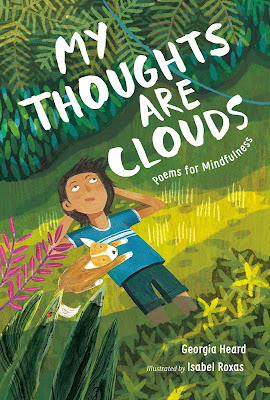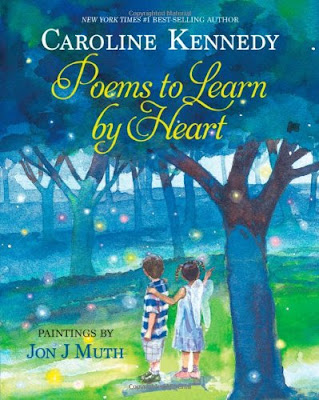My Thoughts Are Clouds: Poems for Mindfulness
Bibliography:
Heard, Georgia. My Thoughts Are Clouds: Poems for Mindfulness. Ill. by Isabel Roxas. New York: Roaring Brook Press, 2021. ISBN: 978-1250244680
Summary:
Using the conventions of poetry, Georgia Heard introduces readers to the basics of mindfulness practice in her beautifully rendered collection My Thoughts Are Clouds: Poems for Mindfulness. Heard makes the case for mindfulness in her introductory note to readers and in poems that compare the mind to a monkey swinging from branch to branch. The following five sections introduce readers to breathing techniques (Breathe in Breath Out), accessible concepts for self-awareness (Mindful Me), poems to sharpen the senses (Mindful World), tools for relaxation and focus (Meditation), and poems to turn compassion outward to other people and all the creatures of the world (Kindfulness). Isabel Roxas’s whimsical and soothing blue and black illustrations combine with Heard’s poetry to create an accessible, helpful, and fun user’s manual that will provide inspiration and relief to restless young readers.Analysis:
For children who need tools to deal with their anxiety, distraction, and restlessness, this book is a godsend. Poetry and illustration are the perfect vehicles to deliver helpful advice to kids who need accessible ways to approach their own uneasy minds with compassion, gentleness, and humor. Readers will identify with the first poem in the collection entitled “Inside My Mind.” The poem is a block of text, all the words connected with no space at all, mimicking the overwhelming onslaught of thoughts: “Ihavesomanythoughtsinmyheadicantstopthemfromracinglikeafasttrain…” Roxas’s illustration depicts a boy whose head is spinning with cartoon lightning, swirls, clouds, and stars. The following poem, called “Quiz: How Mindful Are You?” asks questions in rhyming couplets: “Are you always in a hurry? / Is your mind full of worry? // Does your pulse beat fast? / Do you dwell on the past?” The poem concludes with a comforting pair of stanzas: “If you answered YES / to these questions-- / don’t distress! // Being mindful is the answer, / and here’s the first step how-- / bring yourself back / to the HERE AND NOW.”
The subtle variation of font creates moments of epiphany in several of the poems. In “Counting Breaths,” readers breathe with the poem, inhaling and exhaling:
inhale + exhale ONE
inhale + exhale TWO
The poem instructs the reader to “Breathe / in and out / until counting / F A D E S INTO BREATH…” The numbers begin to become more and more faint as they trail down the page until they disappear completely. This effective use of layout and font creates a profound moment for readers who follow along with their breath. In the poem “Ocean Breath,” the lines appear arranged on a wave surrounding a boy on a surfboard with the instruction to “ride the wave / of your breath.”
The book is packed with useful and memorable metaphors that will serve as tools for kids to use as they work through turbulent emotions. In the poem “My Inner Weather Report,” Heard writes, “Yesterday / a fierce storm / blew in / with bolts of lightning / and thunderclaps. / Pitch-black clouds / hovered overheard, / and it poured / all day long. // Today / I feel / sunny / with gentle breezes / and no clouds at all. / I’m learning to take my inner weather report-- / and notice my feelings / as they come and go.” An illustrated girl wrestles with an umbrella in the rain and then smiles, eyes closed, into the breeze. This profound instruction is certainly valuable for humans of any age.
The book also introduces the concept of mantras, or mind tools, with a haiku: “Change the way you feel: / Choose a sticky-note mantra, / Post it on your heart.” Above the poem floats seven blue hearts with phrases like “I AM ENOUGH” and “I AM PRESENT” and “DON’T LET YESTERDAY TAKE UP TOO MUCH OF TODAY.” Readers might want to write their own mantras on sticky notes and post them in their rooms, notebooks, or bathroom mirrors.
The poems often address common concerns of young students including worrying about homework, missing friends, getting in trouble at school, and feeling sad. In the title poem “My Thoughts Are Clouds,” these worries appear written on the clouds and readers are instructed to watch them sail by and dissolve. It would be difficult to overstate how helpful these practices will be to young people who struggle with their anxious minds.
Poem after poem introduces new ways of thinking that will guide readers to a deeper understanding of themselves and a clearer vision of the world around them. However, even though the ideas and poems have practical applications, the illustrations and designs are so engaging and interesting that readers will have fun with the surprising discoveries that appear on each page. One haiku is even written backwards and readers are instructed to hold the book up to mirror to read the poem. (Spoiler alert: the poem says “When I am mindful / I look into the mirror / at the inner me.”) This is yet another special moment where the thoughtful design of the book leads readers back to themselves. Highly recommended. Ages 8-12.
Excerpt:
“The Music of the Moment”
Listen to the sounds around you
as they rise and pass away.
Let them touch your inner ear.
Slip inside each sound
and allow it to dissolve into air:
rain strumming on your roof, a dog barking far-off
in the night, a ceiling fan whispering…
When you sit in this room of quiet,
where listening ends
and thoughts end,
open yourself
to the music
inside you.
Activity:
- Read the poem “Consider a Raisin” and take time to savor small samples of different foods for a mindfulness taste test. Invite readers to describe how the food tastes, smells, and feels.
- Read the poem “My Thoughts Are Clouds” and invite readers to notice their thoughts and write them on paper clouds and suspend them from a clothesline.
- Incorporate breathing poems into daily routines.
- Invite readers to choose and memorize a poem to recite in times of stress.




Comments
Post a Comment